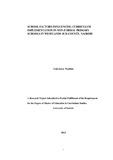| dc.contributor.author | Iraki, Joyce W | |
| dc.date.accessioned | 2014-09-05T13:41:07Z | |
| dc.date.available | 2014-09-05T13:41:07Z | |
| dc.date.issued | 2014 | |
| dc.identifier.citation | Degree of Master of Education in Curriculum Studies, University of Nairobi, 2014 | en_US |
| dc.identifier.uri | http://hdl.handle.net/11295/74174 | |
| dc.description.abstract | The purpose of this study was to investigate school-based factors influencing curriculum implementation in non-formal primary schools in Westlands sub-county. Non-formal primary schools are institutions of learning that caters for out of school children of primary school age. The research objectives of the study were to: examine the extent to which human resource influence curriculum implementation; establish how instructional materials influence curriculum implementation; determine how pupil characteristics influence curriculum implementation; examine the extent to which teaching methods influence curriculum implementation; and to establish how physical facilities influence curriculum implementation. The study adopted a descriptive survey design and targeted six non-formal primary schools which were registered under the Ministry of Education. The population of the study was 306 people and a sample size was 42 participants. A census of administrators was used while random sampling was used to select teachers. The researcher used purposive sampling to pick 24 pupils: that is, only classes 7 and 8 pupils were selected as respondents. This is because they were assumed to be literate enough to understand and respond to the research instrument. A boy and a girl were selected from each class in every school for the purpose of gender balancing in the study. Data were collected by use of questionnaires and observation check list and analyzed using both quantitative and qualitative techniques. The findings revealed that human resource and instructional materials in NFPSs were inadequate. Pupil characteristics were not fully considered in NFPSs while teaching methods were not well varied. The findings also revealed that physical facilities were inadequate. As a result of the findings, it was concluded that the extent of adequacy of human resource was low and therefore affected curriculum implementation in NFPSs. It was also concluded that lack of adequate of instructional materials and physical facilities affected curriculum implementation in NFPSs. It was further concluded that failure to put pupil characteristics in to consideration affected curriculum implementation in NFPSs. It was also concluded failure to vary teaching methods properly affected curriculum implementation in NFPSs. It was also concluded that physical facilities were inadequate and this affected curriculum implementation in NFPSs in Westlands sub-county. Based on the findings, the study recommended that the MOE should provide opportunities for in-service training and institute policies to ensure all teachers participate in the training. The government should provide enough funds to procure adequate instructional materials in NFPSs. The study recommended that NGOs should cooperate with GOK in provision of human resource, instructional materials and physical facilities which are necessary for effective curriculum implementation in NFPSs. The study also recommended that the GOK should set aside land for public utility where sports fields which are accessible to pupils from NFPSs should be provided. The study recommended that the MOE should train and deploy more special education teachers to NFPSs. | en_US |
| dc.language.iso | en | en_US |
| dc.publisher | University of Nairobi | en_US |
| dc.title | School factors influencing curriculum implementation in non-formal primary schools in Westlands sub-county, Nairobi | en_US |
| dc.type | Thesis | en_US |
| dc.type.material | en_US | en_US |

